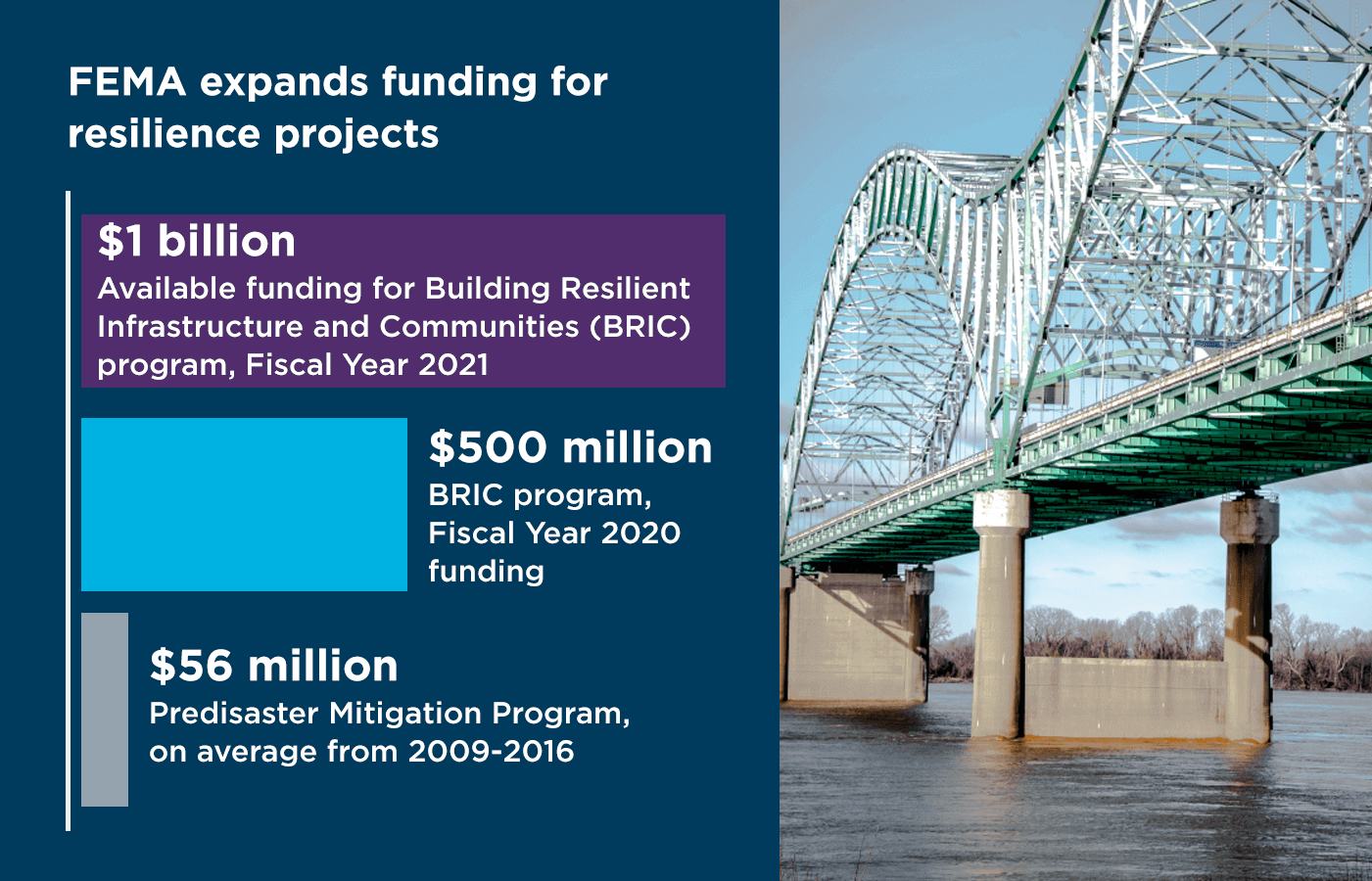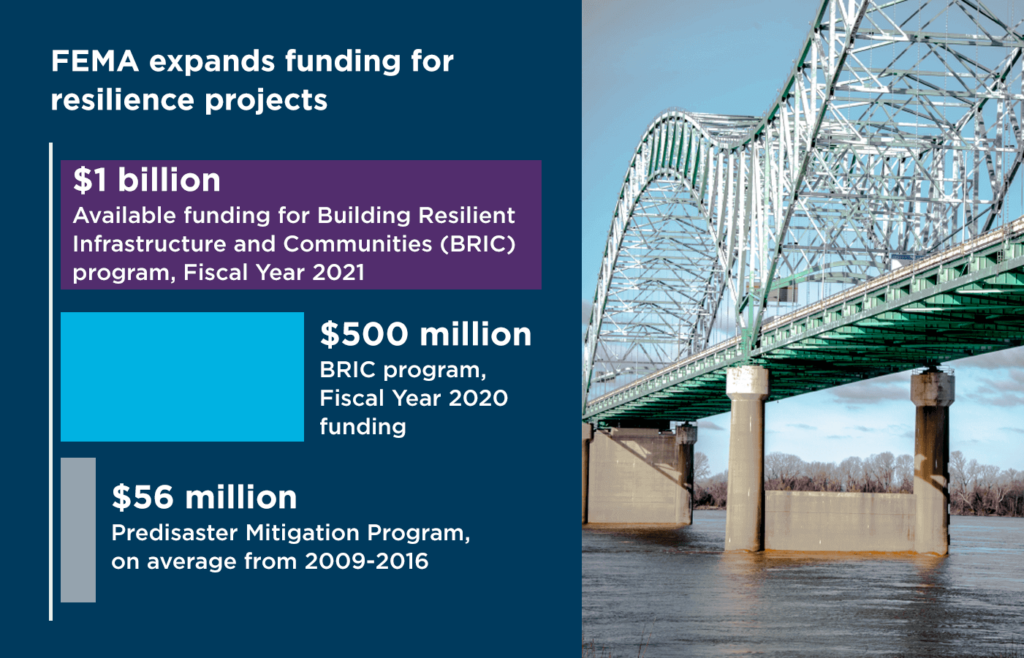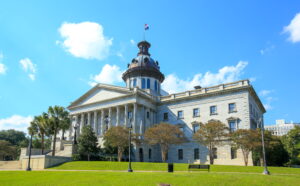January 25, 2022
—
What’s FEMA’S BRIC program and how can your community prepare an application? This post explains everything local leaders need to know about the program, including a checklist of actionable items to help communities apply and examples of eligible projects.
The application period for states, territories, and tribes to apply for the program typically runs from September 2021 through January 28, 2022. This year, FEMA will distribute up to $1 billion through the BRIC program.

BRIC basics
Before we dive in to how to apply, let’s review the basics of FEMA’s Building Resilient Infrastructure and Communities (BRIC) program. Launched in 2021, the BRIC program is a way for states and communities to jumpstart resilience projects.
Created by the Disaster Reform Recovery Act of 2018, the BRIC program funds pre-disaster hazard mitigation projects. Because the BRIC program replaced FEMA’s Pre-Disaster Mitigation program, all activities eligible for funding under the Pre-Disaster Mitigation program remain eligible.
Compared to its predecessor, the BRIC program has a deeper focus on large-scale resilient infrastructure projects and proactive investment in community resilience. Notably, the BRIC program also expands the Pre-Disaster Mitigation program by adding more eligible activities available for funding.
Eligible activities through the BRIC program are divided into four categories:
- Mitigation projects that increase resilience and public safety, reduce injuries and loss of life, and reduce damage and destruction to property, critical services, facilities, and infrastructure. The bulk of BRIC funding goes to mitigation projects. Examples include:
- Nature-based solutions (e.g., investing in aquifer storage and recovery, floodplain and stream restoration, and flood diversion and storage).
- Mitigation reconstruction (e.g., demolishing an existing structure and replacing with a code-compliant, elevated structure)
- Property acquisition and structure relocation
- Structure elevation
- Dry floodproofing (e.g., installing backflow values, internal drainage systems)
- Flood risk reduction (e.g., modifying culverts, constructing retention or detention basins)
- Structural and non-structural retrofitting of existing buildings and facilities
- Capability and capacity building, which helps communities plan or implement flood projects. Specific eligible actions include:
- Building code activities (e.g., evaluating best-suited building codes, adopting or developing building code requirements, and modifying existing building codes)
- Project scoping (e.g., conducting feasibility studies; considering environmental plans and historic preservation; collecting data for benefit-cost analyses, environmental compliance, and hydrologic and hydraulic studies)
- Hazard mitigation planning (e.g., updating or improving current mitigation plans)
- Management costs. Up to 15% of the total amount of the grant award may go to reimbursing the recipient and subrecipient for eligible indirect costs and direct administrative costs.
- Technical assistance. FEMA provides non-financial technical assistance to selected communities, one in each FEMA region, for project- or application-specific needs and broader community-wide resilience needs.
Examples of BRIC in action
In its Mitigation Action Portfolio, FEMA highlights past projects that meet the objectives of the BRIC program, including the following:
- In Buffalo, Wyoming, leaders are using a FEMA grant to update the city’s outdated and inadequate stormwater management system, which was overwhelmed during a 2015 flood. When completed, the $600,000 project will improve safety and security for residents at risk of flooding and mudslides.
- Leaders in Hoboken, New Jersey, combined FEMA and HUD funds to build the Northwest Resiliency Park, five acres of recreational and green space that reduce flooding through green infrastructure and underground rainwater storage. The project also adds social benefits for the community, such as reduced flooding of surrounding roads.
How should communities prepare for BRIC?
Much like its predecessor, FEMA’s Pre-Disaster Mitigation program, the BRIC program considers local governments to be subapplicants that can apply for funds through their state. Rather than apply to FEMA directly, communities may apply for the BRIC program through their state’s emergency management agency.
For more information, local officials should check their state emergency management agency’s website or reach out to state officials. Though it varies by state, many deadlines for communities to apply are months before the application deadline for states, usually in October and November.
This checklist includes actions that communities should take to prepare to apply for the BRIC program:
- Review the FY2021 Notice of Funding Opportunity for BRIC and FEMA’s BRIC resources. FEMA also has resources for applicants, including information on project scoring; support materials on mitigation planning, project scoping and technical assistance; and a mitigation action portfolio with project examples.
- Ensure that your community’s Hazard Mitigation Plan is up to date. To receive funding from BRIC, communities applying as subapplicants must have a FEMA-approved local or tribal hazard mitigation plan by the application deadline and at the time of obligation of grant funds (with the exception of grants specifically for hazard mitigation planning). View the status of your community’s hazard mitigation plan on FEMA’s interactive map.
- Contact your State Hazard Mitigation Officer to learn about the state’s BRIC application process. Deadlines and processes may differ by state, so communities should know their state’s specific requirements.
- Consider applying for technical assistance. Through the BRIC program, FEMA supports a small number of communities with non-financial technical assistance. For example, FEMA can help communities apply benefit-cost analysis methodology to nature-based solutions, or it can help identify partnership opportunities. Note: Communities must submit a letter of interest for direct technical assistance to its state, territorial, or tribal government agency, which may submit letters to FEMA on their behalf. Applications for technical assistance are due January 28, 2022.
- Have at least one staff member complete FEMA’s Benefit-Cost Analysis (BCA) tool training. BRIC applications require a completed Benefit-Cost Analysis, a quantitative way to assess project costs and benefits. FEMA courses provide information on fundamental concepts, obtaining benefit-cost data, and properly conducting a Benefit-Cost Analysis.
- Request a Building Code Effectiveness Grading Schedule (BCEGS) Survey. A building code survey assesses existing building codes and ways communities enforce these codes. Having a higher BCEGS rating will lead to additional points on BRIC applications.
For more on the BRIC program and other federal funding opportunities, check out our Flood Funding Finder, an interactive tool that can help prioritize community needs and identify specific federal assistance programs to fund flood resilience.






